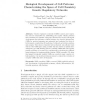Free Online Productivity Tools
i2Speak
i2Symbol
i2OCR
iTex2Img
iWeb2Print
iWeb2Shot
i2Type
iPdf2Split
iPdf2Merge
i2Bopomofo
i2Arabic
i2Style
i2Image
i2PDF
iLatex2Rtf
Sci2ools
101
Voted
ECAL
2005
Springer
2005
Springer
Biological Development of Cell Patterns: Characterizing the Space of Cell Chemistry Genetic Regulatory Networks
Abstract. Genetic regulatory networks (GRNs) control gene expression and are responsible for establishing the regular cellular patterns that constitute an organism. This paper introduces a model of biological development that generates cellular patterns via chemical interactions. GRNs for protein expression are generated and evaluated for their effectiveness in constructing 2D patterns of cells such as borders, patches, and mosaics. Three types of searches were performed: (a) a Monte Carlo search of the GRN space using a utility function based on spatial interestingness; (b) a hill climbing search to identify GRNs that solve specific pattern problems; (c) a search for combinatorial codes that solve difficult target patterns by running multiple disjoint GRNs in parallel. We show that simple biologically realistic GRNs can construct many complex cellular patterns. Our model provides an avenue to explore the evolution of complex GRNs that drive development.
| Added | 27 Jun 2010 |
| Updated | 27 Jun 2010 |
| Type | Conference |
| Year | 2005 |
| Where | ECAL |
| Authors | Nicholas S. Flann, Jing Hu, Mayank Bansal, Vinay Patel, Gregory J. Podgorski |
Comments (0)

